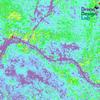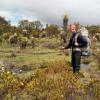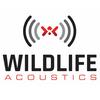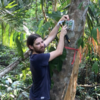Acoustic sensors enable efficient and non-invasive monitoring of a wide range of species, including many that are difficult to monitor in other ways. Although they were initially limited in application scope largely due to cost and hardware constraints, the development of low-cost, open-source models like the Audiomoth in recent years has increased access immensely and opened up new avenues of research. For example, some teams are using them to identify illicit human activities through the detection of associated sounds, like gunshots, vehicles, or chainsaws (e.g. OpenEars).
With this relatively novel dimension of wildlife monitoring rapidly advancing in both marine and terrestrial systems, it is crucial that we identify and share information about the utility and constraints of these sensors to inform efforts. A recent study identified advancements in hardware and machine learning applications, as well as early development of acoustic biodiversity indicators, as factors facilitating progress in the field. In terms of limitations, the authors highlight insufficient reference sound libraries, a lack of open-source audio processing tools, and a need for standardization of survey and analysis protocols. They also stress the importance of collaboration in moving forward, which is precisely what this group will aim to facilitate.
If you're new to acoustic monitoring and want to get up to speed on the basics, check out these beginner's resources and conversations from across the WILDLABS platform:
Three Resources for Beginners:
- Listening to Nature: The Emerging Field of Bioacoustics, Adam Welz
- Ecoacoustics and Biodiversity Monitoring, RSEC Journal
- Monitoring Ecosystems through Sound: The Present and Future of Passive Acoustics, Ella Browning and Rory Gibb
Three Forum Threads for Beginners:
- AudioMoth user guide | Tessa Rhinehart
- Audiomoth and Natterjack Monitoring (UK) | Stuart Newson
- Help with analysing bat recordings from Audiomoth | Carlos Abrahams
Three Tutorials for Beginners:
- "How do I perform automated recordings of bird assemblages?" | Carlos Abrahams, Tech Tutors
- "How do I scale up acoustic surveys with Audiomoths and automated processing?" | Tessa Rhinehart, Tech Tutors
- Acoustic Monitoring | David Watson, Ruby Lee, Andy Hill, and Dimitri Ponirakis, Virtual Meetups
Want to know more about acoustic monitoring and learn from experts in the WILDLABS community? Jump into the discussion in our Acoustic Monitoring group!
Header image: Carly Batist
No showcases have been added to this group yet.
- 0 Resources
- 0 Discussions
- 1 Groups
EcoFirst
Biologist and naturalist involved in NGO's activities as well as profesionnally
- 0 Resources
- 1 Discussions
- 3 Groups
- 0 Resources
- 5 Discussions
- 8 Groups
- @AudreyLooby
- | she/her
University of Victoria
I am Banting postdoctoral fellow at the University of Victoria, focusing on coastal soundscape ecology and underwater noise pollution. I am also one of the co-leads of FishSounds.net.


- 1 Resources
- 5 Discussions
- 5 Groups
- @mdorigo
- | she/her
- 0 Resources
- 0 Discussions
- 3 Groups
- @stefan_istrate
- | he/him
Machine Learning Researcher & Nature Photographer. Building conservation tech for biodiversity monitoring at Wildlife Insights.


- 0 Resources
- 5 Discussions
- 9 Groups
Society for Conservation GIS


- 0 Resources
- 25 Discussions
- 5 Groups
Department of Conservation (New Zealand)
I work with the Terrestrial Biodiversity Team at the Department of Conservation, New Zealand. I'm interested in machine learning and spatial data science.
wekaResearch.com | doc.govt.nz

- 0 Resources
- 9 Discussions
- 4 Groups
GreenLab


- 0 Resources
- 20 Discussions
- 8 Groups
World Wide Fund for Nature/ World Wildlife Fund (WWF)
WWF-Tanzania GIS Specialist/Developer/Trainer
- 0 Resources
- 1 Discussions
- 7 Groups
- @MattyD797
- | He/Him
PhD Student | Cornell University | Smithsonian Institution; My focus is in computational ecology within fishery acoustics


- 0 Resources
- 16 Discussions
- 12 Groups
As a fresh electrical engineer, I am passionate about leveraging technology for biodiversity monitoring, logging, and poaching detection in tropical regions.
- 0 Resources
- 0 Discussions
- 9 Groups
Analysing recordings of gunshots could help save endangered species around the world by identifying poacher hotspots.
7 January 2024
Digital monitoring tools are helping rangers protect wildlife in South America's Atlantic Forest. Could sound-based maps pin down the poaching threat?
7 January 2024
The IQOE Task Team on Low-Cost Hydrophones for Research, Education, and Citizen Science is looking for industry partners to develop a low-cost hydrophone.
15 December 2023
Article
How to engage decision makers for a more sustainable land management for both citizens and landowners in developing countries.
15 December 2023
Sharing our startup's webpage, featuring information about our services and products. We are open for new partnership, collaboration R&D project in the field of GIS data analysis.
15 December 2023
With the support of Women in Conservation Technology (Kenya) and Arm, I had a chance to work with Kijabe Environment Volunteers in Kikuyu Escarpment Forest. This was an opportunity to channel my passion for the...
1 December 2023
Prospective PhD students with a background in acoustics and an interest in Arctic ecology are encouraged to email Michelle EH Fournet
16 November 2023
Sarab Sethi is looking for a PhD student (Sept 24) to investigate real time insect pollinator monitoring with acoustics. Sensor design, ML, lab and field experiments, and more !
16 November 2023
Join the Rainforest Connection & Arbimon team to develop software for biodiversity monitoring!
14 November 2023
I just discovered this freely available book on digital signal processing and love the fact that it is“…intended for students … who may not have much mathematical or engineering training.” Seems like a great resource...
31 October 2023
Baker Consultants has released new ecoacoustic research assessing the benefits of using automated detectors alongside transect bird survey methods.
30 October 2023
Article
Five #tech4wildlife people, projects and updates that caught my attention this month. This issue is a naturetech, biodiversity startup edition! Featuring a living map of the biodiversity startup scene, is nature data...
27 October 2023
August 2025
event
September 2025
event
October 2025
November 2025
event
September 2024
event
event
64 Products
Recently updated products
| Description | Activity | Replies | Groups | Updated |
|---|---|---|---|---|
| As someone from the future, thank you for posting this update! |
|
Acoustics | 5 days 1 hour ago | |
| Dear Colleagues,I hope this message finds you well. I am Manuel Sánchez Nivicela., an independent ornithology researcher based in Ecuador,... |
|
Funding and Finance, Acoustics, Latin America Community | 5 days 20 hours ago | |
| Kudos for such an innovative approach—integrating additional sensors with acoustic recorders is a brilliant step forward! I'm especially interested in how you tackle energy... |
|
Acoustics, AI for Conservation, Latin America Community, Open Source Solutions | 1 week 1 day ago | |
| 🐝 Apis Nomadica Labs: Mapping Royal Jelly Terroir Through Mobile Bee BiotechAbout Us:Apis Nomadica Labs is a mobile apiary research... |
|
Acoustics, Conservation Tech Training and Education, Animal Movement, Human-Wildlife Coexistence | 1 week 2 days ago | |
| Awesome, I think I get what you mean! Thank you! |
|
Acoustics | 2 weeks 2 days ago | |
| This is such a compelling direction, especially the idea of linking unsupervised vocalisation clustering to generative models for controlled playback. I haven’t seen much done... |
|
Acoustics, AI for Conservation, Emerging Tech | 2 weeks 3 days ago | |
| Hi Josept! Thank you for sharing your experience! This types of feedback are important for the community to know about when choosing what tech to use for their work. Would you be... |
|
Acoustics, Latin America Community, Software Development | 3 weeks 1 day ago | |
| Another option you can try is HawkEars, which is a classifier made particularly for Canadian birds. Unlike BirdNET, it doesn't have a graphical interface, though. |
|
Acoustics | 3 weeks 1 day ago | |
| PROJECT UPDATE: We are curating an open-access, annotated acoustic dataset for India! 🇮🇳🌿This project has two main goals:🎧 To develop a freely available dataset of annotated... |
|
Acoustics | 4 weeks 2 days ago | |
| Just to provide an update to my post from 2021. Colleagues and I at the BTO have built a species classifier now for the BTO Acoustic Pipeline for the sound identification of all... |
+10
|
Acoustics | 1 month ago | |
| Thanks @Adrien_Pajot, we are! Also buoys! |
|
Acoustics, Animal Movement | 1 month 1 week ago | |
| I create ocean exploration and marine life content on YouTube, whether it be recording nautilus on BRUVs, swimming with endangered bowmouth... |
|
Acoustics, AI for Conservation, Animal Movement, Camera Traps, Citizen Science, Drones, Emerging Tech, Marine Conservation, Sensors, Sustainable Fishing Challenges, Wildlife Crime | 1 month 2 weeks ago |
Audio Data Across Domains (AudioXD) Workshop
6 June 2022 3:52pm
1 September 2022 3:21pm
Thanks Alice, and great to hear from you and Steph about the work that you all are leading. It would be great to follow up on the idea of doing more international collaboration in the ecoacoustics/bioacoustics space. If you're interested, feel free to drop me a line to catch up sometime about ideas.
Also, something of a side note, but we'll also have a Wildlabs blog post up summarizing the AudioXD meeting soon, hopefully.
26 September 2022 9:22pm
I love the idea of increasing international collaboration and inclusion within acoustic monitoring! I think there particularly needs to be more collab'ing between the terrestrial & aquatic/marine acoustic monitoring folks!
It would be great for more virtual/hybrid events to foster such international inclusion, so anything to facilitate that sort of online platform would be awesome!
There is also the new Bioacoustics Stack Exchange for Q&A. And the upcoming IBAC conference in Japan next October (2023).
Ecological Forecasting Initiative's data analysis webinar series
26 September 2022 6:50pm
New paper: A novel method for identifying coded tags recorded on aquatic acoustic monitoring systems
26 September 2022 2:11pm
Mangrove soundscape
27 August 2022 4:57pm
29 August 2022 2:47pm
You might check out the devices listed in the Conservation Tech Directory - you can search for 'acoustic recorder' or 'ARU' or something like that.
The most common off-the-shelf models (other than Frontier Labs' BARLTs mentioned above😊) are Open Acoustic Devices Audiomoths & Hydromoths (which may be particularly useful for you since they come in completely watertight cases that can be stuck underwater for deployments), Wildlife Acoustics' SongMeter series, and Cornell Lab of Ornithology's Swift units.
30 August 2022 10:10pm
Camilo--
Are you interested only in airborne sounds or do you want to deploy hydrophones? That decision would inform a lot of other decisions about your purchase of equipment, as would having a clearer picture of your budget.
23 September 2022 5:39pm
Hi there Camilo,
What an interesting project! If you are looking for a lower cost, but effective tools for acoustic monitoring you might want to look into two options:
SoundTraps - are very commonly used and perform quite well:
SonarPoints - these are also a great instrument option:
page/sonarpoint | Desert Star Systems
The SonarPoint system is the third generation of Desert Stars passive underwater acoustics monitoring toolkits.
Senior Conservation Technology Expert Position (Consultancy) with the Global Wildlife Program
22 September 2022 5:35pm
New paper: Passive acoustic monitoring as a tool to investigate the spatial distribution of invasive alien species
21 September 2022 2:07am
New paper: Evaluation of a coastal acoustic buoy for cetacean detections, bearing accuracy and exclusion zone monitoring
20 September 2022 3:00pm
New paper: Soundscapes show disruption across the diel cycle in human modified tropical landscapes
20 September 2022 2:40pm
WILDLABS Journal Club
15 September 2022 11:42am
15 September 2022 12:17pm
Ah Journal club - this was a lot of fun but a little chaotic. We've been wondering if we should bring it back with a slightly different format. ie we all agree on a paper to read before rather than bringing a mix of things to present. What does everyone think? Is anyone else keen? Is there a format you'd suggest we use?
15 September 2022 3:49pm
I have been waiting for journal club to come back!! 10000% down.
I agree with @StephODonnell, would love it to come back!!! And now that variety hour is happening, that's more of the "mix of things" that she mentioned anyways so I think that new format would be great.
Online Course – Introduction to Aquatic Acoustic Telemetry
14 September 2022 6:13pm
CFP - transnational biodiversity monitoring (from European Biodiversity Partnership)
14 September 2022 1:42pm
Join the BirdNET team!
9 September 2022 2:43pm
BOEM job openings
Postdoctoral Fellow in Soundscape Ecology at Purdue University
8 September 2022 4:12pm
Catch Up with the Variety Hour: September 2022
6 September 2022 12:31pm
Postdoc: Noise Impacts on Marine Animals
1 September 2022 9:25pm
New paper - 'soundClass: An automatic sound classification tool for biodiversity monitoring using machine learning'
1 September 2022 8:53pm
Solicitation of Interest: NAVFAC Atlantic Marine Resources
31 August 2022 7:28pm
Acoustics Modeler & Analyst, Marine Acoustics Inc
30 August 2022 9:45am
Conservation Technology Research Internship
26 August 2022 4:58pm
New paper: Acoustic indices as proxies for biodiversity: a meta-analysis
22 August 2022 4:03am
Ceres Wild Rhino application
22 August 2022 1:29am
29 September 2022 4:05am
Replacement acoustic membranes for Audiomoth case
31 May 2022 2:15pm
9 June 2022 11:35am
Hi carly,
You've probably seen this already as we tagged you, but I'm dropping it here in case anyone else is having the same issue!
We used the plastic from a stronger A4 plastic folder-case taped. Don't know the type, the one we keep our fieldnotes...
— Attila D. Sandor (@adsandor) June 9, 2022
9 June 2022 1:09pm
@alex_rogers jumping in too:
@groupgetscom has the original vent fitted to the case in stock and available individually - https://t.co/IozIRPVPOS. There is also a UK-based specialist who can provide small numbers of vents - https://t.co/wrQy80Xx0I.
— Alex Rogers (@alex_rogers_cs) June 9, 2022
20 August 2022 9:49am
Alex,
which one of those
https://selectronix.co.uk/collections/waterproof-acoustic-vents
would be the appropriate for the Audiomoth case?
Agus
Looking for plant and animal eco-acoustics specialists in the Alps
10 August 2022 3:01pm
10 August 2022 3:24pm
Hey maya,
If you're free - come along to our Variety Hour call next week and ask folks there too. We're keeping the last 10 mins open for people to jump up and put out calls like this!
Steph
Catch Up with the WILDLABS Variety Hour: August 2022
10 August 2022 11:44am
Product Grant Program
9 August 2022 7:09pm
African Bioacoustics Conference 2022
5 August 2022 3:08pm
IBAC Online Symposium 2022 - Frontiers in Bioacoustics
5 August 2022 2:42pm
Opportunity: Postdoctoral Researcher
4 August 2022 9:08pm
HydroMoth GroupGets campaign
28 June 2022 11:07am
20 July 2022 3:06am
From Alex on Twitter:
Yes. The HydroMoth has the same microphone and firmware as the standard AudioMoth which is widely used for terrestrial conservation. You would need the standard green case which has a waterproof acoustic vent.
20 July 2022 5:57pm
@Andrew_Hill Out of curiosity, since this campaign reached its goal & is ending soon, is it possible to turn the remaining Hydromoth units that didn't sell into Audiomoths for a limited GroupGets? I understand that Hydromoths can be used terrestrially as well, but they are more expensive than the last Audiomoth campaigns have been by $50+ so just wanted to see if Audiomoths would still be cheaper. Just trying to figure out if I should buy more Hydromoths or wait until Audiomoths start selling again (ends up being a trade-off between cost and time basically).
31 July 2022 5:20pm
@Andrew_Hill I wonder if you could let us know more about the time keeping difference btw the regular AudioMoth and the HydroMoth (which is said to do better)?



























































1 September 2022 11:46am
Great minds Alice!! I'd actually sent your workshop to justin separately this morning because of the alignment with audioxd.
As for joining things up globally, I think you're right. Looking at all that's happening in the bioacoustics community right now, seeing all these sort of events, what's happening with the bioacoustics stack exchange, and hearing the conversations that are happening - and it feels like such an opportune time to find a way to support all of these efforts link up and join forces. We have some plans on this front that will mean we'll be able to provide coordination support to help, and I'm interested to hear what people think is needed.
Steph